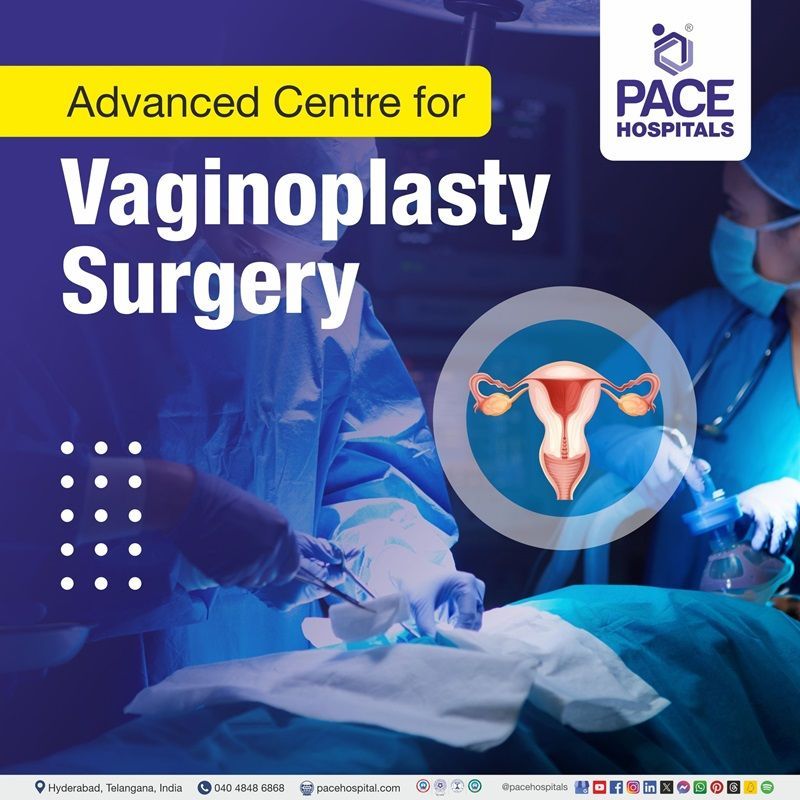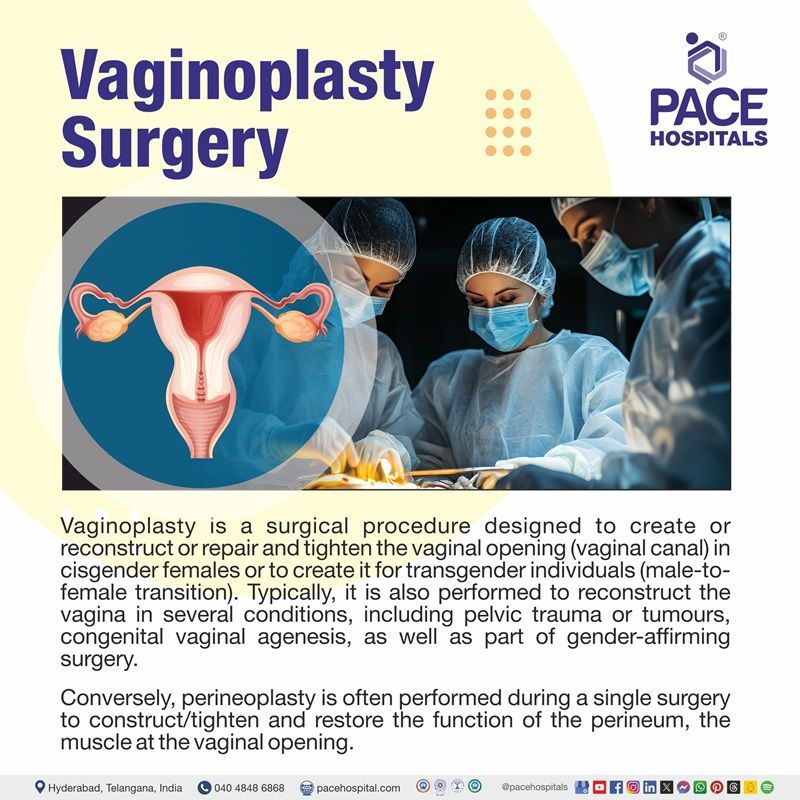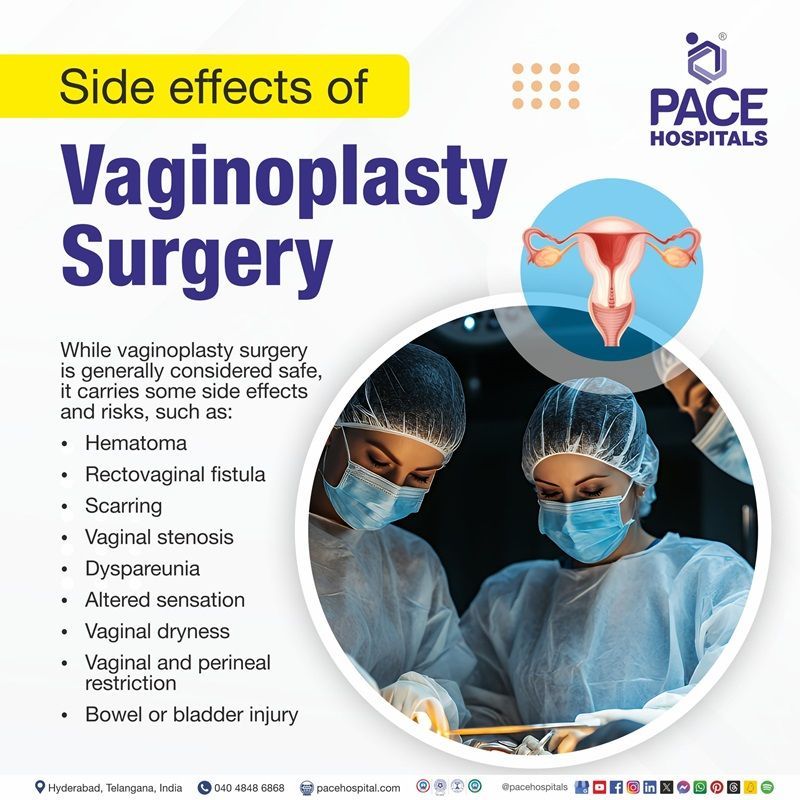Vaginoplasty Surgery in Hyderabad, India | Cost & Procedure Benefits
PACE Hospitals recognized as the Best Hospital for Vaginoplasty Surgery in Hyderabad, committed to providing world-class care. Our multidisciplinary team of highly skilled plastic and reconstructive surgeons, along with urogynecologists, urologists, gynecologists, and colorectal surgeons, offers a multidisciplinary approach to ensure the best possible outcomes.
We utilize advanced laser and laparoscopic surgical techniques, including penile inversion, peritoneal, and buccal mucosa vaginoplasty, tailored to meet the individual needs of each patient. With state-of-the-art facilities, personalized care, and a compassionate approach, PACE Hospitals is the trusted choice for those seeking gender-affirming surgery or reconstructive vaginal procedures.
Request an appointment for Vaginoplasty Surgery
Vaginoplasty Surgery appointment
Why choose us?

1,800+ Vaginoplasty Surgery performed
Team of the Best Plastic and Reconstructive Surgeons in Hyderabad
Precision Treatment with 99.9% success rate
All insurance accepted for Cashless Treatment
Vaginoplasty definition
Vaginoplasty is a procedure that can be performed by gynaecologic or plastic surgeons to surgically repair and tighten the vaginal opening (vaginal canal) in cisgender females or to create it for transgender individuals. Typically, it is also performed to reconstruct the vagina in several conditions, including pelvic trauma or tumors, congenital vaginal agenesis, as well as part of gender-affirming surgery.
Conversely, perineoplasty is often performed during a single surgery to construct/tighten and restore the function of the perineum, the muscle at the vaginal opening.
Although surgical techniques of vaginal tightening (surgery to tighten the vagina) are not new, historically, they have been performed for repairs after childbirth (obstetrical delivery) rather than for improving sexual pleasure or appearance (aesthetic or sexual concerns). However, some studies have shown that surgeries to repair or tighten the vagina usually lead to better sexual function and have few complications.

Vaginoplasty meaning
In vaginoplasty, the word "vagina" is derived from the Latin word "vagina," which means "sexual passage of the female from the vulva to the uterus." The term "plasty" is derived from the Greek word "plastia," which means "act or process of forming," and is also associated with "plastic surgery."
Types of vaginoplasty
Vaginoplasty is a surgical procedure that can be indicated for a variety of reasons, including reconstructive, repair and tightening purposes, feminizing the gender and congenital conditions. There are different types of vaginoplasties depending on the technique used to perform the neovagina, which includes:
- Penile-Inversion Vaginoplasty (MTF vaginoplasty): It is considered the gold standard (best vaginoplasty) for feminizing gender in transgender people (male to female genital reconstruction), which involves inverting the penile skin to create a neovagina.
- Intestinal Vaginoplasty (Colon vaginoplasty): In this procedure, surgeons create a vaginal canal where they use a segment of the intestine and that is often performed when there is insufficient penile or scrotal tissue.
- Peritoneal Vaginoplasty: This newer technique also called as intestinal vaginoplasty or peritoneum pull-through vaginoplasty, uses the lining of the abdominal cavity called the peritoneal lining to create the vaginal canal. It is becoming more popular due to its potential for improved lubrication and reduced risk of hair growth inside the neovagina.
- McIndoe Vaginoplasty: It is also called as McIndoe procedure, involves creating a neovagina using a skin graft, typically from the patient’s thigh or buttocks, which is often performed for patients with congenital (inborn) absence of the vagina (e.g., Mayer-Rokitansky-Küster-Hauser syndrome)
- Buccal Mucosa Vaginoplasty: This technique is often performed when other tissues are not available or suitable, where this procedure involves using tissue from the inside of the mouth (buccal mucosa) to create the vaginal lining.
Vaginoplasty surgery is often performed for a variety of reasons and is indicated in several conditions, including:
- Postpartum vaginal laxity (sensation of vaginal looseness): Gynaecologists may recommend vaginoplasty in cisgender women to address vaginal laxity resulting from childbirth or natural ageing, to enhance sexual satisfaction and comfort.
- Ambiguous genitalia: In some cases, a baby may be born with ambigu ous genitalia (genitalia isn't clear, either male or female) due to conditions like congenital adrenal hyperplasia (CAH) (an inherited genetic condition), causing the body not to produce the right hormones. Vaginoplasty can be part of a set of surgeries to match the person's gender identity and functional needs.
- Vaginal Hypoplasia or Agenesis (like those with CAIS or MRKH): Some people are born with a condition where the vagina doesn’t develop properly or is completely missing in certain conditions such as complete androgen insensitivity syndrome (CAIS) & Mayer-Rokitansky-Küster-Hauser Syndrome (MRKH), where the vaginoplasty is performed as a single procedure to create a functional vagina from other materials or tissues.
- Gender dysphoria: Vaginoplasty is performed on transgender women who feel uncomfortable or dissatisfied with their biological sex and gender identity. It is often part of their gender affirmation process, helping align their physical appearance with their gender identity.
- Aesthetic reasons: Some women seek vaginoplasty for cosmetic reasons (cosmetic vaginoplasty), wanting to improve the appearance of the vagina. This may be driven by personal preferences or self-esteem considerations.
- Sexual Function: Vaginoplasty may be considered to improve sexual health and satisfaction for women with significant sexual function issues or vaginal pain due to structural abnormalities.
- Genital Trauma or injury: Injury to the vaginal area from accidents or other physical trauma may necessitate surgical reconstruction.
- Cancer: Vaginoplasty is helpful in cancer patients who may need vaginal reshaping and reconstruction after undergoing radiation to treat cancer.
Vaginoplasty contraindications
Women who have the following conditions are not recommended to undergo vaginoplasty:
- A history of vulvodynia: It is a chronic pain or discomfort in the vulva (outer part of female genitals)
- Dyspareunia: Painful sexual intercourse that can be experienced before, during, or after intercourse caused by a number of medical or psychological factors.
- Bowel and bladder control issues: Difficulty with bowel movements or problems with urinary or anal control
- Pelvic organ prolapse: Dropping of the muscles and tissues supporting the pelvic organs (rectum, uterus or bladder) into the vagina due to weakness.
- Rectocele: Dropping or bulging of the rectum into the vagina
- Cystocele: Dropping or bulging of the bladder into the vagina
- Chronic pelvic pain: Pain in the pelvic region that lasts for a long term
Vaginoplasty advantages
Vaginoplasty procedure primarily reduces the width of the vagina for reasons of function and well-being and the advantages of vaginoplasty include:
- Restore vaginal tightness
- Enhanced sexual satisfaction
- Enhanced aesthetics
- Improved quality of life
- Improvement in physical function and psychological well-being
Considerations of Gynaecologist or Plastic surgeon before planning vaginoplasty
Before planning vaginoplasty for a specific person, a surgeon takes the following into consideration:
- History: Surgeons consider the obstetrical and gynaecological history of the patient, including:
- Delivery method: How the woman gave birth
- Trauma of vaginal child birth: Vaginal childbirth can be physically traumatic, especially if tools like forceps or a vacuum are used.
- Multiparity: Multiple pregnancies
- Macrosomia: Baby is much larger than average, or has excessive birth weight
- Other medical conditions: Evaluation for vaginoplasty and perineoplasty candidates should include assessment for following:
- Urinary incontinence: Whether the patients have urinary continence (urine leaking issues) and other issues related to the pelvic area.
- Pelvic organ prolapse (POP), such as rectocele and cystocele: A cystocele is associated with urinary frequency, urgency, and incontinence; a rectocele is associated with constipation, including a history of digital manipulation to facilitate defecation.
- Vaginal examination: Gynaecologist considers how wide the vagina is and how well the supporting pelvic muscles are working.
- Body mass index: Having a high body mass index (BMI > 30) can raise the risks in any person. However, it is a particular concern in women interested in vaginoplasty and perineoplasty because extra weight puts a lot of strain (pressure) on the pelvic floor, which can lead to problems including pelvic organ prolapse (POP), leakage of urine (urinary incontinence), cystocele (bulging of the bladder into the vagina) and rectocele (bulging of the rectum into the vagina).
- Menopause: A gynaecologist can consider the menopausal woman's overall health, hormone levels, vaginal tissue condition, and potential risks, as well as her psychological readiness and expectations, before planning vaginoplasty.
- Realistic expectations: Managing expectations of patients is essential, especially when considering vaginoplasty for cosmetic reasons. Open communication between the surgeon and patient helps establish realistic goals and outcomes.
- Risks and benefits: Surgeons assess the risks and benefits of vaginoplasty for each patient to prevent potential complications.
Women considering vaginoplasty should consult with experienced healthcare professionals (gynaecologists or plastic surgeons) to explore their options and make informed decisions based on their unique needs and goals.
Vaginoplasty preparation
Vaginoplasty preparation (before surgery) involves several essential steps to ensure optimal outcomes and minimize complications. This includes:
Quitting smoking: Stoppage of tobacco before surgery is important because it can reduce the risk of potential complications and improve the results of the procedure.
Assessments: Before vaginoplasty, a patient may have certain tests to evaluate hormone levels, especially in menopausal women, detect infections, and assess anatomical structures and overall health.
Hormonal preparation: Postmenopausal patients considering vaginoplasty will be recommended to be on oestrogen to thicken their vaginal tissues before surgery.
Specific preoperative requirements: For individuals assigned male at birth (AMAB) undergoing vaginoplasty for gender affirmation, specific preoperative requirements, such as genital hair removal, are reviewed with the healthcare expert.
Anaesthesia: Vaginoplasty is performed using either general anaesthesia (the patient sleeps completely) or a pudendal block (numbing of the lower part of the body).
Vaginoplasty procedure
Vaginoplasty is typically performed as an outpatient procedure, depending on patient preferences, circumstances and the complexity of the surgery. The vaginoplasty steps may include:
- Injection of special fluid mixture: A mixture of special fluid is injected in tissues that are present between the vagina and rectum to control bleeding (haemostasis) and act as a cushion to help prevent an abnormal connection between the vagina and rectum.
- Marking: Once the required tightening amount is determined, a pie-shaped wedge is marked to outline the excess skin to be removed from inside the vagina.
- Incision: Then, the surgeon makes an incision in the vaginal opening or vagina canal. The location and length of incisions depend on the specific issues being addressed.
- Tissue resection and tightening: Excess or damaged tissue may be removed, and the remaining tissues are tightened using strong sutures to restore the natural elasticity of the vagina.
- Muscle repair: During vaginoplasty, the surgeon lifts the inner vaginal lining to access the pelvic muscles and then stitches them together to enhance muscle tone and support.
- Suture closure: The incisions are carefully closed with dissolvable sutures, minimizing scarring and promoting optimal healing.
- Revision vaginoplasty: It is a surgical procedure performed to correct or improve the results of an initial vaginoplasty.
Post vaginoplasty
Post-vaginoplasty recovery involves careful management of certain things and the patient should follow specific instructions to ensure optimal outcomes, including:
- Pain management: Patients may experience mild discomfort, which can be managed with prescribed pain medications. Applying ice packs to the surgical area can help reduce swelling. Keep the area elevated, and use a squirt bottle for comfort while urinating in the shower.
- Activity restrictions: During the first weeks of recovery, it is recommended that patients avoid strenuous activities such as heavy lifting and vigorous exercise. However, they are encouraged to engage in simple activities and gradually resume daily routines.
- Hygiene and wound care: Maintaining good hygiene is crucial for preventing infections. Patients are typically advised to avoid baths and use a peri-bottle for gentle cleansing. The surgical site should be kept dry and clean.
- Sex after vaginoplasty: After undergoing vaginoplasty for vaginal laxity, it is essential to wait for a few weeks before resuming sexual activity to allow for proper healing.
- Follow-up appointments: After surgery, regular follow-up appointments and screening with the surgeon about current reproductive health can be helpful in the healing process and address any concerns. This ongoing medical support ensures optimal outcomes and patient satisfaction.
Recovery from vaginoplasty
Vaginoplasty recovery varies from patient to patient, but generally, it may take 6-8 weeks. However, this depends on multiple factors, including the patient age, overall health, emotional factors, severity of the condition, adherence to post-operative care instructions, specific surgical technique used, and type of vaginoplasty, etc.

Vaginoplasty side effects
While vaginoplasty surgery is generally considered safe, it carries some side effects and risks, such as:
- Hematoma: Pooling of blood outside of a blood vessel
- Rectovaginal fistula: An abnormal connection between the rectum and the vagina may result in stool leakage into the vagina.
- Scarring: Hardening or thickening of tissue due to vaginoplasty
- Vaginal stenosis: Narrowing of the vaginal canal
- Dyspareunia: Painful sexual intercourse
- Altered sensation: Changes in feeling or sensitivity in the vaginal area
- Vaginal dryness: Lack of moisture in the vagina
- Vaginal and perineal restriction: Limited movement or tightness in the vaginal and perineal areas
- Bowel or bladder injury: Damage to the urinary bladder or intestine
- Following postoperative care instructions can minimize the risks mentioned above.
Questions that the patients can ask the healthcare team about Vaginoplasty surgery?
- What are the wound care instructions for my incision site?
- How soon should I contact the healthcare team if I notice any unusual symptoms or issues after the procedure?
- What signs of complications or infections should I watch for at the surgical site?
- When can I go back to my normal activities?
- Are there any specific activities I should avoid during my recovery period?
- What dietary restrictions should I follow for recovery?
- When should I schedule follow-up appointments?
- Will any tests or evaluations be required after the surgery?
Difference between Vaginoplasty and Labiaplasty
Vaginoplasty vs Labiaplasty
Vaginoplasty and labiaplasty are two vaginal tightening techniques aimed at enhancing comfort and aesthetic appearance. The following outlines their differences:
| Elements | Vaginoplasty | Labioplasty (vulval surgery) |
|---|---|---|
| Procedure | Surgical reconstruction of vaginal canal | Surgical alteration (reducing the size) of labia minora |
| Purpose | To tighten, reconstruct or repair the vaginal canal, often after childbirth, due to ageing or gender confirmation. | To enhance aesthetically or to relieve discomfort from enlarged labia. |
| Process | Involves surgical techniques to alter vaginal structure. | Involves trimming or reshaping the labia. |
| Indications | Post-childbirth changes, congenital abnormalities, aesthetic concerns or gender-affirming surgery. | Cosmetic concerns, physical discomfort, or asymmetry. |
| Impact on sensation | May enhance or alter sensation depending on technique. | May alter sensation, but often not significantly. |
Frequently Asked Questions (FAQs) on Vaginoplasty Surgery
Who is a candidate for vaginoplasty?
Candidates for vaginoplasty typically include cisgender woman who is seeking for vaginal tightness and those suffering from certain medical conditions affecting their reproductive anatomical structures, transgender women looking for gender-affirming surgery, and non-binary individuals wanting vaginal reconstruction. Surgeons consider multiple factors before choosing ideal an candidate for vaginoplasty such as individual expectations, preferences, age, risk factors, etc.
How tight can be vagina after vaginoplasty?
The vagina will be immediately tighter and have a smaller diameter after a vaginal tightening procedure such as vaginoplasty, which aids in restoring the vaginal tightness and its supporting structures to their pre-pregnancy state. However, over time and with age, the vaginal walls may lose some tightness.
Is vaginoplasty the same as vaginal rejuvenation?
No, but it is a type of vaginal rejuvenation. Vaginoplasty specifically focuses on tightening or reconstructing, or repairing the vaginal canal due to ageing, often after childbirth or due to medical conditions and trauma. Whereas vaginal rejuvenation can include a combination of different surgical interventions aimed at enhancing the appearance and function of the vaginal area, which may involve vaginoplasty but also includes other techniques.
What are the benefits of vaginoplasty?
Vaginoplasty offers several functional and cosmetic benefits, including increased tightness and comfort in the vaginal canal, which can enhance sexual satisfaction by increased sensation and friction during intercourse, decreased vaginal looseness, and a generalized feeling associated with vaginal laxity. It also improves the aesthetic appearance of the vaginal area, boosting self-confidence. Additionally, this procedure provides adequate support for pelvic organs, reducing issues like prolapse.
What does vaginoplasty treat?
Vaginoplasty is performed for both functional and cosmetic reasons. There are many reasons why an individual may decide to seek vaginoplasty. Some of those reasons include vaginal childbirth, ageing, vaginal reconstruction and reshaping after undergoing radiation to treat cancer, certain congenital conditions and feminizing gender (gender affirmation).
What is the success rate of vaginoplasty?
Several studies report that the success rate of vaginoplasty surgery, especially for male-to-female transgender individuals, can be as high as 90–95% when performed by experienced surgeons. However, the success rate of vaginoplasty varies depending on several factors, including the surgeon's experience, the surgical technique used, and the individual’s health and post-operative care. Post-operative care and adherence to medical advice (including dilation therapy) are crucial in achieving the best outcomes.
What is average cost of vaginoplasty in Hyderabad, India?
Vaginoplasty cost in Hyderabad can vary from ₹1,00,000 to ₹1,85,000 (US$1,190 - US$2,200), depending on several factors, including the type of procedure, the hospital facilities, patient’s medical condition & age, the qualifications and experience of the surgeon, the type of anesthesia used, any additional procedures (like labiaplasty for cosmetic refinement), insurance cashless coverage, pre- and post-surgery care, follow-up consultations, psychological evaluation and dilation kits (which are necessary for long-term vaginal maintenance in some types of vaginoplasty). Here's a detail cost for the respective type of vaginoplasty procedure:
- Penile-Inversion Vaginoplasty: Approx. cost - ₹3,50,000 to ₹5,00,000 (US$4,170 to US$5,950)
- Intestinal Vaginoplasty: Approx. cost - ₹3,25,000 to ₹4,75,000 (US$3,870 to US$5,650)
- Peritoneal Vaginoplasty: Approx. cost - ₹4,00,000 to ₹6,50,000 (US$4,750 to US$7,740)
- McIndoe Vaginoplasty: Approx. cost - ₹4,25,000 to ₹6,75,000 (US$5,050 to US$8,030)
- Buccal Mucosa Vaginoplasty: Approx. cost - ₹4,50,000 to ₹7,50,000 (US$5,350 to US$8,900)
It is important for a person considering vaginoplasty surgery should consult with a multidisciplinary team including plastic surgeons, urologists, gynecologists, and colorectal surgeons to obtain personalized estimates. This ensures a clear understanding of the potential costs, procedure details, and associated risks before proceeding with plastic and reconstructive surgery or gender-affirming surgery.




